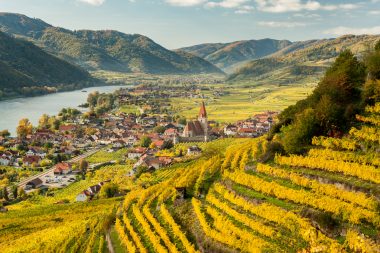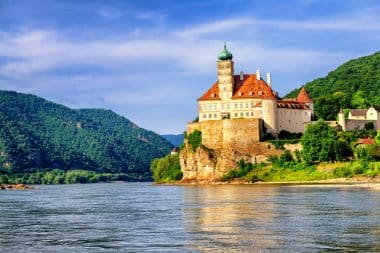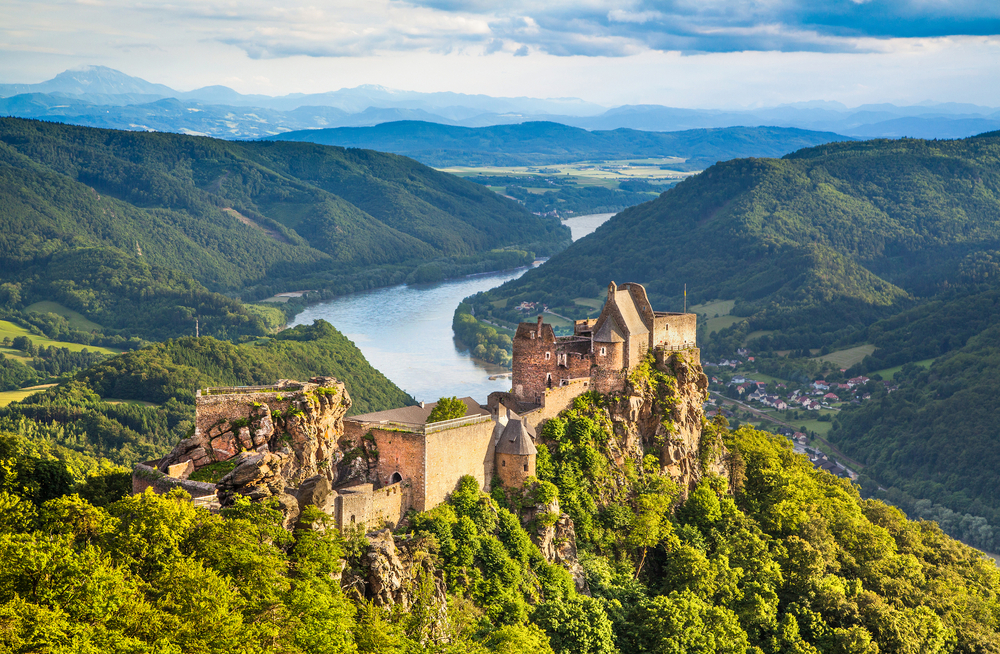Anyone who has ever treated themselves to an unusual gastronomic pleasure in the Wachau and had the regional specialities served in a wine tavern will get very close to the soul of this lovely Austrian region. And as a guest, you can be sure that you won’t be sitting alone at one of the rustic tables for very long. The young wine served there and the cheerful songs connect people. Wachau – that is also the baroque view of the gentle waves of the Danube. Visitors to this area sometimes have to commute from one bank to the other, and it doesn’t really matter where they end up. The winegrowers are already there with their Heuriger. Often, from the green heights, a stone saint looks down from the portals of the impressive sacred buildings to the lively hustle and bustle at their feet.
A lovely valley between Melk and Krems

There are plenty of eye-catchers for holidaymakers when visiting the Wachau. And yet this section of the Danube Valley is only 36 kilometers long. It stretches from Melk with its impressive monastery to Krems with the historic buildings of an old town. Here and there you can see dressed-up young people with their colorful traditional costumes. They don’t just wear them at the folk festival after the apricot harvest. The Wachau rarely presents its austere face. Actually, only downstream, where the vineyard terraces are lost and rugged rocks rise out of the green forests. Otherwise, the Wachau is like the stage of a long history. It is a country where life sometimes wrote comedies and then tragedies again.
Wachau – of monks, knights and the Nibelungs
The Wachau has always been a sought-after destination. From monks from Bavaria who refreshed the wine supply of their monasteries here. Of the legendary Nibelungen, which set off from there in the direction of Hungary. From secular rulers, knights, conquerors and, more recently, of course, from the millions of tourists who hope to find their own personal Eldorado in the Wachau. Some of them don’t really know whether they love the urban aspect of this landscape or the charm behind defiant facades or simply the lushly blooming oleander that can be admired at almost every archway to light-flooded arcaded courtyards. The Wachau is like a secluded garden for life-affirming guests.
Fine wines from wooden barrels
Connoisseurs of this region swear by the fact that the best of all fine wines is served in the romantic backyards of the winegrowers. At the wine growers’ Heurigen, it is customary for the pint to be accompanied by a Brettl- or Hauerjause. For almost all winegrowers, it consists of cheese, meat, a spread usually produced by the winegrowers and various garnishes. However, the gates to these small culinary paradises do not open in all seasons. Actually, only for a few weeks, when their own wine is ripe, to leave the cellar vaults and the wooden barrels. Then you should not overlook the often hand-painted boards with the inscription “Ausgsteck ist”.
“Entwined by the silver ribbon of the Danube…”
The Wachau is two things: a landscape to feel good in and a UNESCO World Heritage Site. On exactly 1,344 hectares, wines of the best quality grow on the steep terraces in the narrow valley of the great river. Among other things, the Riesling and the Grüner Veltliner. The Austrian national poet Franz Grillparzer raved about this region as early as the 19th century with the words: “Entwined by the silver ribbon of the Danube, it rises up to hills full of wine.” The much-travelled writer was fond of physical pleasures and was a frequent guest of the winegrowers in Lower Austria. If you look at these impressive hills from a ship, you will look up to the ruins of once proud castles, Schönbühel Castle, the striking towers of the Maria Laach pilgrimage site and the baroque church of the Augustinian Canons’ Monastery.
When the Wachau is enthroned on a pink cloud

The mostly cheerful people in this lovely stretch of land on the Danube are convinced that it was none other than “the good God” who gave them the apricot. The sweet to sour-tasting fruit with its velvety skin grows on almost a hundred thousand trees in the Wachau. And when the buds of the apricots open on a warm spring day, it looks to visitors as if the Wachau is floating on a pink cloud. After the harvest, it can be found in many products of this region. In tasty cakes, in dumplings, in strudel and even in high-proof brandy. It is the pleasant climate of the Wachau that helps the farmers to achieve high yields of their apricots.
Where Umberto Ecco was inspired
If you want to enjoy and experience the Wachau with all your senses, you will probably start your tour in Krems. And thus in a cultural city with a unique town centre. Romantics go to the Schreckberg at sunrise and look from there over to Göttweig Abbey with its “Museum in the Imperial Wing”. As an insider tip for “Fernblicker”, the view from the Ferdinand-Warte is also recommended. You don’t have to be very good on foot to hike to some of the most beautiful castles. For example, the ruins of Dürnstein or the ruins of Aggstein. In the castle above Dürnstein, which sees itself as the “Pearl of the Wachau”, England’s King Richard the Lionheart once languished. A trip to the Wachau is also a journey to sinners and saints. The latter can be found in the gigantic Melk Abbey, which is one of the most beautiful baroque ensembles on the continent. The bestselling author Umberto Ecco was inspired there for his novel “The Name of the Rose”.
General information
The Wachau is a valley in Lower Austria along the Danube between the cities of Melk and Krems. The region is particularly known for its beautiful landscape, viticulture and as a UNESCO World Heritage Site. It covers an area of about 18,000 hectares and attracts visitors with its unique combination of natural beauty and historical sights.
Climate
The Wachau enjoys a temperate climate that is ideal for viticulture. Summers are warm, but not overly hot, while winters are mild. This climate, together with the fertile loess soils of the region, creates perfect conditions for the vines.
Sights
- Melk Abbey: A magnificent Benedictine monastery that towers over the town of Melk and is known for its impressive Baroque architecture and library.
- Dürnstein: A picturesque place, known for its blue church and the castle ruins where Richard the Lionheart was once imprisoned.
- Wineries: The Wachau is famous for its wineries, which invite you to visit and taste them. The wines Grüner Veltliner and Riesling are particularly well-known.
- Krems: One of the oldest cities in Austria with a well-preserved medieval town centre, museums and galleries.
Activities
- Wine tastings: Visit the local wineries to taste some of Austria’s best white wines.
- Hiking and cycling: The region offers numerous hiking and cycling trails along the Danube and through the vineyards.
- Boat tours: A trip on the Danube offers a wonderful perspective on the landscape of the Wachau.
- Visiting festivals: Wachau hosts several annual festivals, including the Apricot Blossom Festival in spring and Wine Autumn in autumn.
Culture
The Wachau has a rich cultural history, which can be seen in its many well-preserved medieval towns and monasteries. The region also maintains living traditions in viticulture and fruit growing, especially the famous apricots.
Gastronomy
Wachau cuisine benefits from local products such as wine and apricots. Typical dishes include fresh fish specialties from the Danube, game from the surrounding forests and, of course, desserts with apricots.
Journey
The Wachau is easily accessible by car or train from Vienna and is only about an hour away from the capital. Its proximity to Vienna makes it a popular day or weekend getaway for visitors and locals alike.


